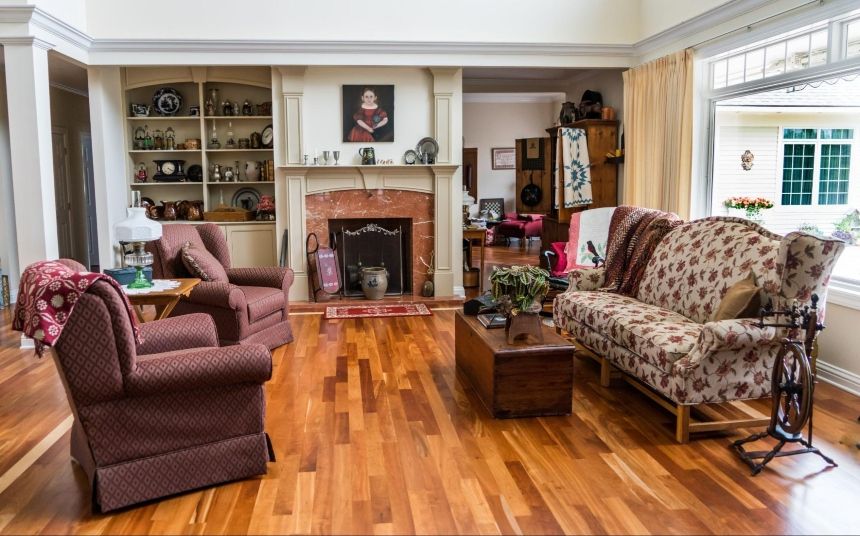Hardwood Floor Installation Process

Installing your hardwood floor begins before you even choose and purchase your hardwood floor. As the choices you make will affect the installation process. This article will cover those choices such as the finish, the pattern, preparing the subfloor, and choosing your intermediate layer as well as the installation process itself including installation using an easy clip system, glueing your hardwood flooring and expansion gaps.
Hiring a Professional
Before we get to the rest of this article it is important to note that unless you are experienced and confident in your abilities to install your solid wood flooring yourself then hiring a qualified and experienced professional is recommended.
Determine your Finish Pattern
It is generally advised for the best aesthetics that you lay your hardwood flooring planks parallel to the longest side of the room. Staggering the rows is also the most common choice, a difference of 6 inches between seams for regular-width planks and between 8 and 10 inches for extra-wide planks is the norm.
Determine Plank Width
Consider the size of your room when choosing the right plank width for your solid wood flooring. In a small room wide planks may make it look even smaller, so a narrow-width plank under 149mm would work. However, for a large room, a narrow plank may make it look too busy. In a big room wide planks between 150mm and 190mm would be better.
Building Requirements
The building must be airtight before laying your hardwood floor. Any works which add moisture to the building, such as plastering and painting must also be completed. This will prevent additional moisture from warping the flooring but also makes good sense in case of spillages or messes which you don’t want to mark or damage your solid wood flooring. The heating system should also already be installed and working and if the season allows it should be in use when laying the floor.
Subfloor Requirements
Whether your subfloor is made of screed, concrete, lightweight concrete, wood or a mix of materials it must be level, uniform and smooth. To check whether your subfloor is level enough use a 1.5-metre straight edge and lay it on the floor there must be no more than a 2mm gap anywhere. If you are using a 2-metre straight edge this increases to 3mm. If you intend to glue your hardwood flooring in place - you should sand or fill as required to ensure adequate smoothness required for the best level of adhesion.
Temperature, Moisture and Humidity
- The ambient temperature of the building is ideal for installing a hardwood floor at 20 degrees.
- The relative humidity (RH) of the building must be between 35 and 65. You can find the RH by using a hygrometer.
- The recommended residual moisture levels of the subfloor depend on what it is made of:
Screed should not exceed 90%.
Concrete should not exceed 75%.
Wood should not exceed 12.%
If you are not experienced in taking these measurements you should hire a professional as this is key to protecting your floor from warping or splitting.
Acclimatisation
Always check the manufacturer's guidelines regarding the acclimatisation of your solid hardwood flooring. The majority of the hardwood flooring that we sell at Wooden Floors UK does not need to be acclimatised. In fact, it should be laid immediately on delivery where possible and should be unwrapped from its packages at the point of installation, no sooner.
Floor Installation
Intermediate Layer
The intermediate layer adds additional soundproofing, thermal insulation, moisture protection, and comfort. Options for your intermediate layer include floor cardboard, flooring-grade polystyrene, foam, polyfoam or a moistureproof membrane. Your requirements will depend on a variety of factors including flooring height, level of thermal insulation required, ventilation spaces, and moisture levels. We recommend getting in touch with us to discuss the best options for you.
Clip System Hardwood Flooring
Clip system flooring is quick and easy to install. We advise that you check the manufacturer's instructions but the installation process follows these steps:
- Check and follow the manufacturer’s recommendation for clip spacing - this is likely to be around the 500mm mark.
- Take the first plank and turn it over.
- Using a hammer gently knock the end of the clip which has the hole into the groove on the reverse of the plank.
- The end of the clip without holes will now be facing the tongue part of the plank - this is the direction you will be laying next.
- Place the board ensuring that the tongue end is facing away from the wall also that you leave the expansion gap which should be 2mm per metre on either side and a minimum of 15mm.
- Consider using an expansion strip or spacers to keep the expansion gap clear. Continue this process with the next plank joining and glueing them together at the head end (widthways).
- It is extremely likely you will need to trim the final board to fit (remember the expansion gap) and use the off-cut of the trimmed board to start the next row.
- For the next row, a wooden block is useful for tapping the rows together.
- When you get to the final row you might need to trim the board lengthways to fit and to allow for the expansion gap.
- With the final row, you should glue the boards lengthwise - this is the only time you should be doing this.
If you are installing flooring in a hallway and need to continue to lay it on the stairs there is a previous article on how to install wooden flooring on stairs that you should take a look at.
Glueing a Hardwood Floor
- If your subfloor is concrete or scree the best option may be to glue down your hardwood planks.
- In some cases you may need to add a moisture barrier, this could be a liquid moisture barrier or a PE moisture barrier depending on other factors such as what the subfloor layer is made of.
- The subfloor must not only be level and smooth but also clean to ensure the best level of adhesion. We recommend sanding and/or filing as necessary.
- Ensure you have the right tool for applying the adhesive - this will be either a plastic or metal spatula.
Feeling Daunted?
If you are a seasoned DIYer, perhaps you have installed wood flooring before then our clip system hardwood floors no doubt will be a breeze for you.
However, if reading this guide left you feeling like it might be a step too far for you, don’t panic.
We always recommend that unless you are really confident that you enlist the help of a professional. This will ensure the job is done properly and fast and most importantly with the least stress for you!
Reach out if you would like to be put in touch with an expert in installing solid wood flooring or for any other advice regarding your wooden flooring choices.


